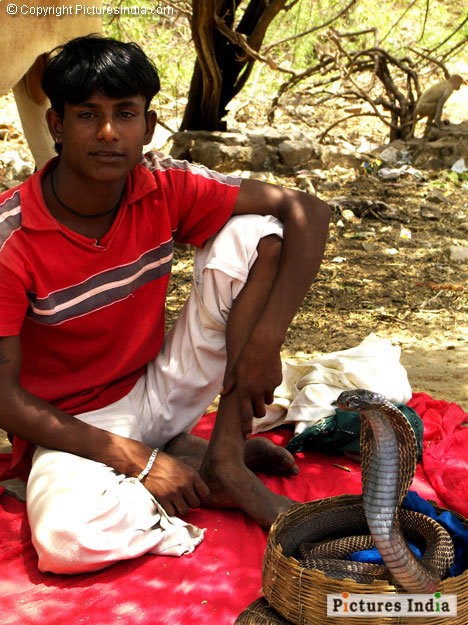
India, the land shrouded in mystery and exotic charm… Think India… does the image of snake charmers and mystics come immediately to your mind? Then the story of Nag Panchami will definitely be of interest to you! A festival celebrated across India on the 5th day of the moonlit-fortnight in the month of Shravan. According to the Hindu calendar, in 2011 this important festival falls on the 4th of August. Though celebrated across the country, Southern India, Maharashtra and Bengal are the best places to enjoy the celebrations.
While there are many legends behind the festival, a popular one is that of a farmer. It is said that a farmer inadvertently destroyed an anthill that housed young snakes once while ploughing his field. So enraged was the mother snake that on her return she promised to kill the farmer and his family. That night when the farmer slept, she entered the house and bit the farmer and his family. Then remembering the farmer’s eldest daughter lived in the neighboring village with her in laws, she proceeded towards the village.
However, impressed by the girl’s plea, the snake gave the girl some nectar which would bring the famer and his family back to life when sprinkled on them.
Another popular myth revolves around the young lord Krishna, it is said that once Krishna was playing with the other cowboys, when the ball they were playing with got entangled in a tree by the Yamuna. The river being home to a terrible snake Kaliya, none of his friends volunteered to get the ball. On climbing the tree, Krishna accidently fell into the river and came across Kaliya the snake. When Krishna caught it by its neck, the snake realized that this was no ordinary boy and pleaded for his life. Krishna allowed it to go after the snake promised not to trouble anyone again. This is also the reason why Krishna is referred to as “Kaliya Mardan”.
The snake is also associated with Lord Vishnu, the thousand-headed Shesh Nag symbolizing ‘Eternity’ is the couch Lord Vishnu rests on. Hindus also believe it is on this couch that the Lord reclines between the time of the dissolution of one Universe and creation of another. Hindus believe that the snake is immortal due to the shedding of its skin. Indian mythology also says that the elder brother of Lord Krishna, Balram was the incarnation of Seshnag on earth.
Images of Lord Shiva also show a snake around his neck and according to some Nag Panchami celebrated during the month of Shrawan (considered as the month of Lord Shiva in Hindu religion) is a tribute to the snake as his companion.
Another reference to snakes in Indian mythology is made in the Puranas, with historians claiming that the Naagas were Kings of various kingdoms which were worshipped as Gods.
Buddhism and Jainism also credit the snake as a creature with divine qualities, as ancient texts claim a cobra snake saved the life of Buddha and the Jain Muni Parshwanath.
However a more logical explanation offered is during the monsoons (Shravan), snakes come out of their flooded holes, or are found floating on rivers. In earlier days, the fear of snakes due to the high mortality rate led them to be elevated to this divine status.
As snakes are believed to like milk, on Nag Panchami milk is often poured into holes near the anthills or near Nag Temples by devotees; in Bengal Mansa (the Queen of Snakes) is worshipped on this day.
Different parts of India follow different traditions, while in some places images of snakes are drawn on wooden boards, with red sandalwood, in Punjab a snake is made of dough and paraded around the villages with a lot of festivities, after which it is buried, while in states like Maharashtra, snakes are offered kumkum, haldi, milk and flowers as offering.
Though it is believed that snake worship was started by the Indo-Aryans, evidence proves otherwise dating this worship to as early as 3000 B.C. As snakes play a significant part of Indian mythology and religion, on this day temples dedicated to snakes (Sarpa) are visited by devotees who make special offerings of flowers, milk and haldi. In many areas across India, food in the form of rice is offered and cobras are given a ceremonious bath in milk. Drinking of the milk by a snake is considered highly auspicious.
Even in Indian literature and architecture, the importance of snakes in India culture is not ignored, dating back centuries, The Ajanta caves that date back to the 2nd century BC have carvings of snake worship. While some say that this festival was initially observed to worship the forces of Mother Nature, over the years it changed to honor God’s ferocious creation – the snakes.

